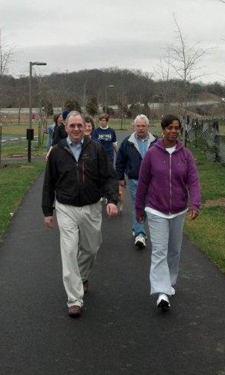 Gathering at Highbanks Metro Park in Columbus, Ohio, on an early Saturday morning, dozens of people of all ages prepare to take a brisk 30- to 45-minute walk on the Big Meadows Trail. It’s the Walk with a Doc program, and it’s happening in more than 100 locations across the country as well as in Canada, Australia and Russia.
Gathering at Highbanks Metro Park in Columbus, Ohio, on an early Saturday morning, dozens of people of all ages prepare to take a brisk 30- to 45-minute walk on the Big Meadows Trail. It’s the Walk with a Doc program, and it’s happening in more than 100 locations across the country as well as in Canada, Australia and Russia.
Walk with a Doc was founded by Columbus cardiologist David Sabgir, M.D., in 2005 to counteract the epidemic of chronic diseases like diabetes and obesity. The concept is simple. You need a committed corps of volunteer physicians and a park and recreation agency that is willing to host a walking event in its local park system. Either a hospital or regional healthcare system sponsors Walk with a Doc, which provides a source of general physicians, cardiologists and pediatricians to lead the walks. A sponsor can also provide funding for marketing, apparel and healthy snacks at walking events.
A typical Walk with a Doc program begins with the doctor discussing a relevant health topic and answering questions asked by the participants. At many locations, health assessments such as blood pressure tests are performed by a nurse or medical-school resident. Then the walkers hit the trail with the doctor at their side, continuing the health dialogue.
Dr. Sabgir organized the Walk with a Doc program when office talks failed to motivate patients to exercise. “More than 90 percent of the diseases my patients and I tackle together in the office or the hospital are related to a sedentary lifestyle, yet it has been reported that only 3 percent of people are achieving the appropriate amount of exercise each week,” Sabgir laments. “Frustrated by the inability to increase my patient’s activity level, I told them I would be at the park on Saturday and would love for them to join me.” And they have been walking ever since.
In May, Kentucky One Health, a recently formed healthcare system, partnered with Louisville Metro Parks to launch Walk with a Doc at Iroquois Park. Dr. Jesse Adams, Kentucky Chapter of American College of Cardiology, brought the idea forward, and Kentucky One Health’s Alice Bridges put it in motion.
“We are moving from a focus on ‘sick care’ to true preventive healthcare,” Bridges asserts. When asked why it was important to locate Walk with a Doc in a park, Bridges replies, “Connecting with the natural world is critical to achieving wholeness and health.”
On July 13, Waterford Recreation and Parks in Connecticut, partnering with Lawrence-Memorial Hospital, held its inaugural Walk with a Doc program at the Waterford Community Center. Recreation and Parks Director Brian Flaherty is excited about the prospect of engaging the community in healthy activities.
“Walk with a Doc will help make the connection between health and parks and recreation in our community,” he says.
The impact on the health, fitness and wellness of those who participate is powerful. More than 90 percent of participants say they feel more educated, 75 percent exercise more, 70 percent feel more empowered and nearly 99 percent enjoy the concept of pairing physicians with communities outside traditional settings. The “healthy people, healthy parks” connection grows stronger every day.
Learn how to start Walk with a Doc in your park system.
Mark A. Young is with Parks Forever Consulting in Worthington, Ohio.

